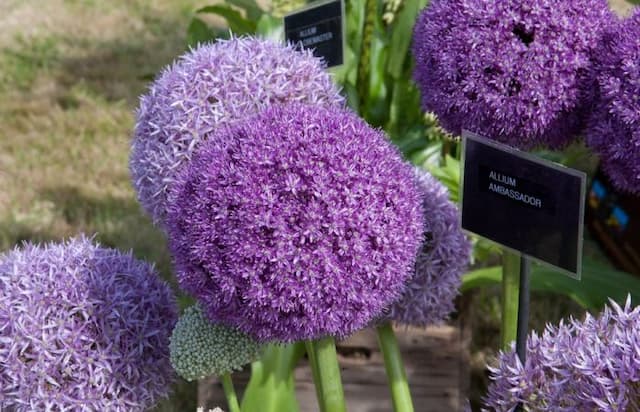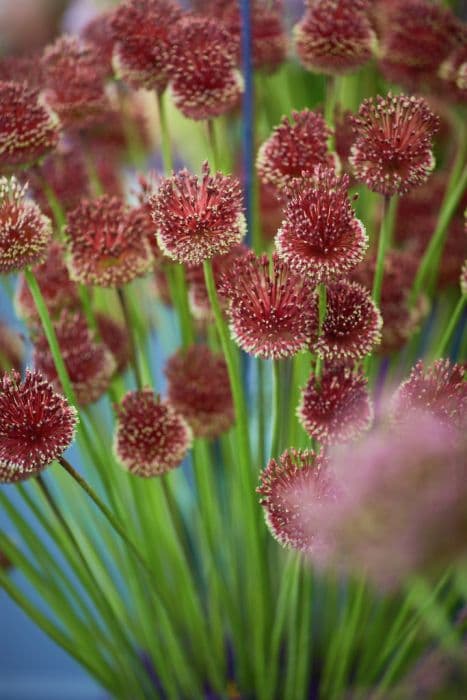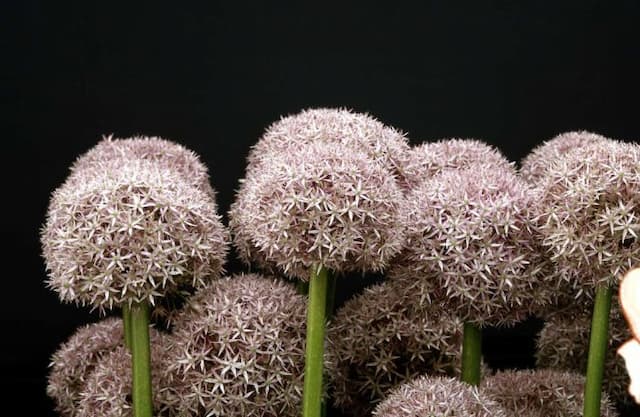Chilean Lily Gethyum atropurpureum

ABOUT
The plant commonly referred to as Desert Lily or Onion Lily boasts an intriguing and exotic appearance. It features a cluster of bulb-shaped bases that give rise to strap-like leaves, which typically have a slightly waxy or fleshy texture, indicative of the plant's ability to store water. These leaves emerge at the base of the plant and spread outwards, sometimes arching gracefully. The most striking feature of the Desert Lily is its flower stem that rises from the center of the leaf cluster. The stem is topped by an inflorescence of striking flowers, which are arranged in an umbrella-like cluster. These flowers are typically of a deep, brooding purple, almost appearing blackish in some light, lending the plant its name due to their dark hue. The flowers themselves are bell-shaped, with a slight flare at the open end, showcasing the inner detailing and sometimes lighter color variations. Completing its striking appearance, the plant may also exhibit seed pods that follow the flowering period, elongating and providing a textural contrast to the flowers' delicate form. Overall, the Desert Lily's beauty lies in the juxtaposition of its lush, green foliage base against the deep purple-black hues of its distinctive flowers. The combination of these features together creates a visual spectacle that makes this plant a unique and captivating addition to any environment it adorns.
About this plant
 Names
NamesFamily
Amaryllidaceae
Synonyms
Chilean Lily, Purple Gethyum
Common names
Beauverdia atropurpurea, Nothoscordum atropurpureum.
 Toxicity
ToxicityTo humans
Gethyum atropurpureum, commonly known as widow's onion, is not extensively documented for its toxicity to humans. There is limited information available on the specific toxic compounds or the symptoms of poisoning that might occur from ingesting this plant. As with many plants that are not well studied, it would be prudent to avoid ingesting widow's onion or using it for medicinal purposes without clear scientific evidence of its safety. If any part of the plant is accidentally ingested and adverse symptoms appear, seek medical attention promptly.
To pets
The toxicity of Gethyum atropurpureum, known commonly as widow's onion, to household pets such as dogs and cats is not well documented. There is a lack of specific information regarding the toxic substances present in widow's onion and the symptoms that might result from its ingestion by pets. Therefore, it is advisable to err on the side of caution and prevent pets from consuming any part of this plant. If you suspect your pet has ingested widow's onion, it is important to monitor them for any signs of distress or unusual behavior and consult with a veterinarian as soon as possible.
 Characteristics
CharacteristicsLife cycle
Perennials
Foliage type
Deciduous
Color of leaves
Green
Flower color
Purple
Height
1 foot (0.3 meters)
Spread
1 foot (0.3 meters)
Plant type
Bulb
Hardiness zones
8
Native area
Chile
Benefits
 General Benefits
General Benefits- Ornamental Value: Gethyum atropurpureum, commonly known as Black Garlic, adds a unique aesthetic to gardens with its striking purple flowers and uncommon appearance.
- Drought Tolerance: Adapted to dry environments, Black Garlic is suitable for xeriscaping, reducing the need for irrigation and water consumption in landscaping.
- Pollinator Attraction: Its flowers can attract pollinators such as bees, which are crucial for the pollination of many plants and overall ecological balance.
- Culinary Use: While not a primary use, some parts of Black Garlic might be used for culinary purposes, adding a unique flavor or decoration to dishes.
- Educational Value: As an unusual plant, Black Garlic can be used for educational purposes to teach about biodiversity and plant adaptation strategies.
 Medical Properties
Medical PropertiesThis plant is not used for medical purposes.
 Air-purifying Qualities
Air-purifying QualitiesThis plant is not specifically known for air purifying qualities.
 Other Uses
Other Uses- Gethyum atropurpureum, commonly known as Chilean onion, can be used as an ornamental in xeriscaping due to its drought tolerance and unique flowering structure.
- The strong fibers of the Chilean onion's leaves are sometimes used in traditional crafts and weaving in their native regions.
- The bulbs of the Chilean onion can be used as a natural dye for textiles, providing a range of color depending on mordants used.
- In some cultures, the Chilean onion is incorporated into floral arrangements for its distinctive and dramatic appearance.
- The strong scent of the Chilean onion's flowers may be utilized as a natural rodent repellent in agricultural settings.
- The plant's resilience to pests can provide environmental benefits by reducing the reliance on pesticides in gardens where it is grown.
- Gethyum atropurpureum may be studied for its adaptability to harsh growing conditions, contributing to research in climate change mitigation strategies.
- The seeds of the Chilean onion could be used in educational settings to demonstrate plant growth and bulb development to students.
- Due to its unusual appearance, the plant could be used in artistic installations and landscape design to provoke thought and conversation about biodiversity.
- Some culinary enthusiasts may experiment with the edible parts of the plant in niche gourmet dishes, provided they are prepared safely avoiding any toxic parts.
Interesting Facts
 Feng Shui
Feng ShuiThe plant Gethyum atropurpureum, commonly known as Keati flower, is not used in Feng Shui practice.
 Zodiac Sign Compitability
Zodiac Sign CompitabilityThe Keati flower is not used in astrology practice.
 Plant Symbolism
Plant Symbolism- Uniqueness: Gethyum atropurpureum, commonly known as the "Chilean Lily" or "huilli," is not a well-known plant, which can symbolize the beauty and importance of standing out and being unique in a world of commonality.
- Mystery: With its rare appearance and limited information available, the Chilean Lily represents the allure of the unknown and the appeal of uncovering hidden truths.
- Survival: Native to the Andes, the Chilean Lily symbolizes resilience and the ability to thrive in harsh, challenging environments, much like its capacity to survive in mountainous regions.
- Rarity: As the Chilean Lily is not commonly found in cultivated gardens, it represents the concept of rarity and the value of preserving endangered or scarce elements of nature.
- Natural beauty: The striking dark purple to black flowers of the plant showcase the diverse palette of nature's beauty, symbolizing the depth and complexity that exists within natural aesthetics.
 Water
WaterThe Chilean Lily should be watered deeply, ensuring that the soil becomes moist but not waterlogged. It prefers a well-draining soil, so it's important to allow the top inch of soil to dry out before watering again. Typically, watering once a week with about one to two gallons, depending on the size of the plant and the environmental conditions, is sufficient. During the active growth period in spring and summer, consistent watering is crucial. However, reduce the frequency of watering in the fall and further in winter when the plant is dormant.
 Light
LightThe Chilean Lily thrives best in full sun to partial shade. An ideal spot would be where the plant can receive at least six hours of sunlight daily, with some dappled shade during the hottest part of the day to prevent leaf burn. The plant should be protected from intense, direct afternoon sun through strategic positioning or the use of shading cloth.
 Temperature
TemperatureThe Chilean Lily can tolerate a range of temperatures but thrives best when the daytime temperatures are between 50 and 75 degrees Fahrenheit. Nighttime temperatures should not drop below 40 degrees Fahrenheit. It can survive minimum temperatures as low as 28 degrees Fahrenheit, but for brief periods only.
 Pruning
PruningPruning the Chilean Lily is not typically required, but if necessary, remove dead or damaged foliage to maintain plant health. The best time for pruning is in the late winter or early spring before new growth begins. This plant doesn't require rigorous pruning, so any necessary cutting back should be done sparingly and only to shape the plant or remove unhealthy parts.
 Cleaning
CleaningAs needed
 Soil
SoilGethyum atropurpureum, commonly known as the Chilean lily, thrives in well-draining soil with a pH ranging from 6.5 to 7.5. A good soil mix for this plant includes equal parts of loamy soil, sand, and peat to promote drainage and aeration. Ensure the soil is rich in organic matter to support its growth.
 Repotting
RepottingThe Chilean lily should be repotted every two to three years or when it outgrows its current container. This will prevent it from becoming root-bound and will ensure the continued health of the plant by providing fresh nutrients and soil.
 Humidity & Misting
Humidity & MistingThe Chilean lily prefers moderate humidity levels. Aim for a humidity level around 40-50% which is often the typical indoor humidity range. This plant does not require extremely high humidity to thrive.
 Suitable locations
Suitable locationsIndoor
Place Chilean lily in bright, indirect light and ensure good air flow.
Outdoor
Plant Chilean lily in partial shade, sheltered from strong winds.
Hardiness zone
8-10 USDA
 Life cycle
Life cycleGethyum atropurpureum, more commonly known as Onionweed, begins its life cycle as a seed, which when conditions are suitable, sprouts and forms a small bulb. The bulb then sends up a shoot which will later through photosynthesis enable the growth of leaves and eventual flowering. During the flowering stage, Onionweed produces distinctive purplish flowers, generally in a cluster, to attract pollinators. After pollination occurs, the flowers develop into seed capsules containing numerous seeds. These seeds are dispersed by various means, such as wind or animals, and when they land in conducive soil, they germinate and the cycle begins anew. Onionweed dies back to its bulb after seed dispersal, entering a period of dormancy, particularly in adverse conditions, until the next growing season.
 Propogation
PropogationPropogation time
Spring to summer
Gethyum atropurpureum, commonly known as Chilean onion, is usually propagated through seeds, as it is the most popular method. The best time to sow seeds is in late winter to early spring when the temperatures start to rise but are not yet too warm. After collecting the seeds from the ripe capsules of the plant, sow them in well-draining soil and cover lightly with soil. The seedbed should be kept moist until germination, which typically takes a few weeks. It's important not to let the soil dry out during this period but also to avoid waterlogging which can cause the seeds to rot. Seedlings can be transplanted to their permanent location once they've developed a few true leaves and are large enough to handle.









